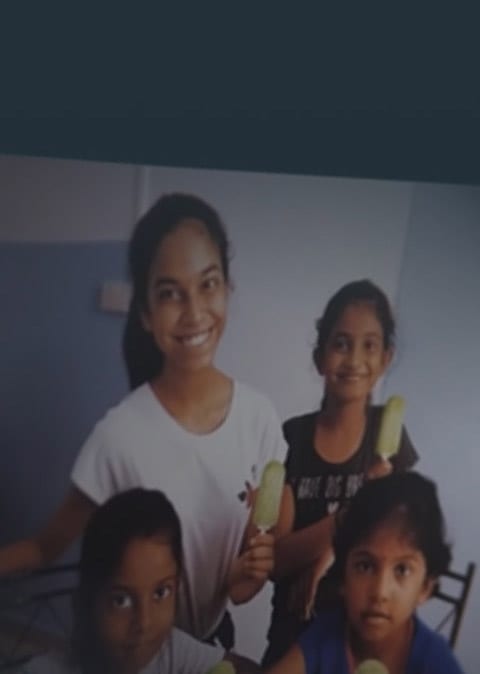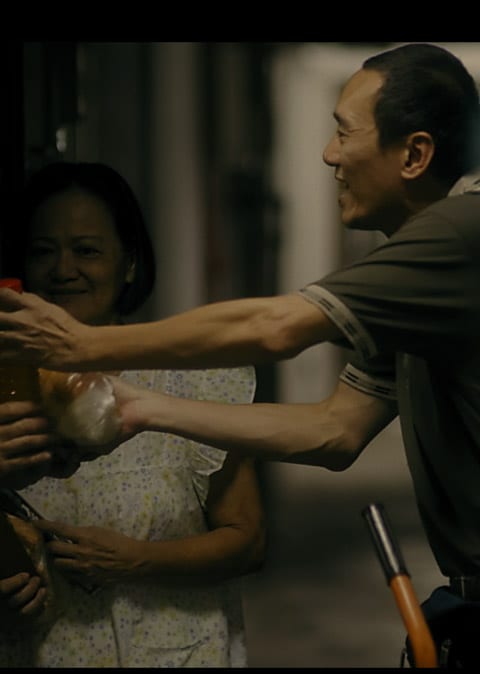
ISSUES iN THE
Low Income
Space in Singapore
Key insights to guide your giving
Financial Distress
of low-income households surveyed face challenges in paying off their debts.1


Why you should care
Low-income households with unstable or inadequate income struggle with their finances. Unexpected crisis such as retrenchment or sudden illness could upend the family financial situation overnight. In particular, the elderly, those with chronic health issues, and/or those with multiple dependants are at greater risk of financial distress. 2,3
Households in the lowest 20% of income group were the only group whose income growth was lower than their expenditure.4 Many also find themselves in chronic debt, which further creates psychological burden. Some struggle with family members with unhealthy spending habits, which hinders the financially strapped family to better direct their finances on unmet needs.5 All these factors make it difficult for low-income households to make better financial decisions on a day to day basis to get out of poverty.6 Ongoing financial distress further spills over to feelings of loss of control, anxiety and other mental health conditions.
What are the existing forms of support
ComCare is a key social assistance scheme in Singapore’s social safety net which provides assistance for low-income households who need financial help. ComCare provides monthly cash assistance to help cover basic living needs and assistance with household bills and medical expenses. Based on the families’ needs and circumstances, the Ministry of Social and Family Development (MSF)’s Social Service Offices (SSOs) will also facilitate access to other relevant services and support by government agencies and community partners. In FY 2018, ComCare assisted 37,436 low-income households.7
Social workers from various social service agencies also work with low-income families under assistance to better manage their finances by assessing their needs and wants. With continuous engagement, they co-create solutions with families themselves and identify resources needed to realise their hopes and vision.5
What more could be done
Although support from ComCare and other forms of social assistance is available, these schemes do not cover all forms of chronic debts/arrears and some families may not be aware of these assistance schemes. Families with urgent need for money may still resort to borrowing from illegal loan sharks. Unlicensed money-lending cases registered increased by 15% from 4,608 in 2018 to 5,301 cases in 2019.8
It also takes time for low-income families to stabilise their income situation and build their savings. Financial literacy programmes with a matched savings component have proved to be a useful intervention with long-tail positive impact.
How you could help
Help close the last mile gap. ONE (SINGAPORE)’s Emergency Fund disburses in-kind and financial assistance to low-income individuals and families who urgently need assistance but, are unable to get it elsewhere or cannot obtain it in time due to procedural delays.
Support programmes that encourage good saving habits. Methodist Welfare Services’ Family Development Programme (FDP) matches two dollars for every dollar that beneficiaries set aside to pay off chronic debt or towards savings, capped at $200 monthly.
1 Ng, I.Y.H., & Ong, Q (2016). Working with low income families in Singapore: Proceedings of Social Service Research Centre (SSR) Conference 2016. Singapore: National University of Singapore
2 Chan A, Malhotra R, Manap NB, Ting YY, Visaria A, Cheng GH-L, Goh VSM, Tay PKC, Lee JML, Maulod A. Transitions in Health, Employment, Social Engagement And Intergenerational Transfers In Singapore Study (THE SIGNS Study) – I: Descriptive Statistics and Analysis of Key Aspects of Successful Ageing. 2018. Singapore: Centre for Ageing Research and Education, Duke-NUS Medical School
3 Donaldson, John A.; Smith, Catherine J.; Balakrishnan, Balambigai; Kadir, Mumtaz Md.; and Mudaliar, Sanushka. Elderly Population in Singapore: Understanding Social, Physical and Financial Needs. (2015). 1-42. Lien Centre for Social Innovation: Research.
4 Department of Statistics (2019) Report on the Household Expenditure Survey 2017/18. (Note: Over a third of these households were headed by persons aged 65 years and over in 2017/18. The difference between the growth in monthly household income and expenditure in the HES do not necessarily equate to changes in saving/dis-saving rates. Households may finance their expenditure through irregular receipts such as the proceeds from the sale of properties, lump-sum CPF withdrawals, insurance claims or ad-hoc transfers that are not part of their regular income.)
5 Nair, S. (2018) $500 a month on cable TV and cigarettes and this family still wants aid? Retrieved fromThe Straits Times
6 Ong, Q.Y., Theseira, W. & Ng, I.Y.H. (2019). Reducing debt improves psychological functioning and changes decision-making in the poor. Proceedings of the National Academy of Sciences Apr 2019: 116 (15) 7244-7249; first published March 25, 2019
7 Ministry of Social and Family Development (2018) ComCare Annual Report FY2018
8 Singapore Police Force (2020). Annual Crime Brief 2019.
Low Wage Work and Retirement Adequacy
Why you should care
Low wage and income inadequacy are arguably at the heart of the multiple stressors faced by low-income population. With rising cost of living, this segment struggles to cope with daily expenses.
This results in them forgoing expenses on longer term needs, including not being able to optimally invest in children’s education, delaying medical attention, and having adequate saving for contingencies such as illness and breadwinner’s job loss.
What are existing forms of support
Amongst the multiple layers of support for lower-wage workers and their families, the Workfare Income Supplement (WIS) seeks to uplift the wages of these workers and helps them save for retirement through cash and CPF top-ups. Over 400,000 workers receive WIS payouts annually. Progressive Wage Model (PWM) addresses low and stagnant wages caused by cheap sourcing in the cleaning, security and landscaping sectors, with the real median monthly gross wages of full-time resident workers increasing cumulatively by 26%, 36% and 30% in these sectors respectively between 2014 and 2019.3
What more can be done
Many low-wage workers are employed under outsourced service contracts. As business-to-business outsourced industries, some of these essential service players compete for contracts based on competitive costing. This incentivises employers to keep wages low and give minimal employee benefits.
Employers and service buyers should adopt a performance and quality-based approach to contractual terms by specifying service-level requirements rather than by headcount, to address the negative effects of competitive costing. Employers could also incorporate technology solutions to enhance productivity or experiment with innovative business models. In addition, employers and service buyers should offer no worse-off remuneration and benefits packages and recognise the lengths of service of incumbent workers whom they intend to employ under new contracts.
How you could help
Support employment services programmes like New Hope Community Services’ “Build New Hope” Job support and Retention programme, which extends specialised help by a job coach in partnership with social workers to displaced persons. The programme assists them to restore their confidence in themselves and help them transition to a stable state of sustained employment. Job coaches work closely with employers to facilitate workplace adjustment. In the last 2 over years, this programme has successfully matched more than 300 individuals into jobs, of which 264 of them have achieved sustained employment for at least 3 months.
Commit to fair employment practices through innovative means. Nimbus, a cleaning start-up, embraces technology and automation to keep operations lean thereby distributing its productivity gains to workers by offering higher than industry average wages whilst providing opportunities for upskilling and cross-training to workers.
1 Comprehensive Labour Force Survey, Manpower Research and Statistics Department, MOM (June, 2019)
2 Ministry of Manpower (2020) Report: Labour Force in Singapore 2019.
3 People’s Action Party (2020) Why no minimum wage? (Note: Median monthly gross wage (excluding employer CPF) of full-time resident employees, deflated by Consumer Price Index for all items at 2019 prices (2019=100).)
Inequality in Child Development and Education
Why you should care
Children from low-income families may face multiple challenges, which can put them behind the starting line in life’s race. Those with incarcerated parents or single parents may be at even greater risk. Intervening early and holistically can help to break the intergenerational transmission of poverty by giving children from low-income families a better start in life.
For some low-income families, parents may face challenges in supporting their child’s education and development, as they have less resources to invest on them, due to their often demanding, unpredictable and/or low-wage jobs. Some cut back or forgo enrichment activities for their children as a means to manage their arrears and finances.2 Access to holistic developmental opportunities should be ensured for all children, including those from low income families.
What are existing forms of support
The annual governmental spending on early childhood education has increased from around $360m in 2012 to around $1 billion today and is expected to increase to more than double in a few years. Beyond increasing the government-supported share of preschool places from just over 50% today to 80% by around 2025, the Government has enhanced preschool subsidies from January 2020 to make preschool more affordable for low- and middle-income households.3
What more can be done
Even with more accessible and affordable preschool, parents from low-income families may still grapple with resource and time constraints. Some may require additional support in enhancing parent-child relationships, or stimulating their child’s language development at home. Supporting initiatives that work with low-income families to enhance their child’s development would go a long way towards giving children from low-income families a better start in life.
How you could help
Contribute towards shaping lives of children. The Early Childhood Development Agency’s KidSTART initiative enables children aged 0 to 6 from low-income families to have a good start in life by supporting parents with child development, coordinating and strengthening holistic support for families where needed, and monitoring the developmental progress of children from birth onwards. Contribute by donating to or volunteering with the ‘Growing Together with KidSTART’ initiative, thereby providing families with essential items such as milk and diapers, transport for children to attend preschool or KidSTART programmes, and children’s learning resources. Contributions can also go towards top-ups of KidSTART children’s Child Development Accounts (CDA) which will be matched by the Government, up to the CDA matched savings caps.
To find out more information about Growing Together with KidSTART, visit the link: https://www.ecda.gov.sg/Parents/Pages/KidSTART.aspx
Care Corner Singapore’s Circle of Care project is a preventive care model for early childhood development that fosters home-school-community partnerships and integrates social work, learning support, health services and parental involvement to promote holistic care and positive outcomes for children, in particular those from vulnerable backgrounds.
1 Chong, W.H., Choo, H., Goh, E.C., Wee, P.Y., Goh, W.H., Chay, O.M. Preventive child healthcare in Singapore: A parents’ well-being perspective. Annals Academy of Medicine, Singapore. 2015 Dec;44(12): 550-553.
2 Ministry of Social and Family Development (2013) Study on the Experiences of Lower-Income Households in Singapore,2011
3 Early Childhood Development Agency (2020) Enhanced Support for Preschool Operators and Families
Caregiver Support
women
are not working due to housework and caregiving responsibilities.1
women
have quit their jobs for housework and caregiving.1
Why you should care
Life expectancy of women in Singapore is over 85 years old.2 However, for the most part of their productive years, women may have to spend time away from the labour force for domestic work and caregiving duties. For low income women, the consequence of this trade-off is even more dire. Consequently, they earn less, suffer from skills deterioration, and lose out in career advancement.
Some face challenges and stress arising from sudden family circumstances (e.g. onset of illness on a family member) and may not have sufficient family and social support to rely on. Those who have to give up their job altogether are likely to be left with little savings and are at risk of suffering more financial difficulties in their later years.3,4
With better employment and caregiving support, low income women can build and sustain financial independence for themselves and their families while contributing to the economy.
What are existing forms of support
Greater caregiving support is provided through making childcare and eldercare services more affordable and accessible. More subsidies are also being provided for more low and middle-income families.
There are also various national schemes and initiatives that promote the adoption of flexible work arrangements (FWAs) and to facilitate upskilling and employment support for entrance to the workforce. Some of which include, the Work-Life Grant which provides companies funding support to implement and sustain FWAs as well as, Adapt & Grow, Workforce Singapore (WSG’s) Careers Connect and SkillsFuture.
There are also a range of affordable care options and financing measures for caregivers of aged dependents such as caregiver grants and subsidies, caregiver respite options as well as caregiver training and empowerment.
What more can be done
Accessible support for working adults to balance caregiving and paid employment requires a collaborative effort from employers, service providers and the community.
Employers could do more to support employees in their caregiving responsibilities by providing flexible working arrangements. As it is, low-income mothers often find childcare operating hours incompatible with their working hours which tend to be unpredictable or fall on weekends or evening/night shifts.3 Paid eldercare leave could also be helpful especially in the context of Singapore’s aged society.4
How you could help
Help caregivers take a much-needed break.
CareNights@Morning Star helps families in need get respite from caregiving by operating from 6 pm to 10 pm every weeknight. Similarly, Agency for Integrated Care’s Go Respite is a pilot programme that encourages caregivers to plan ahead and pre-enrol their loved one with their preferred senior care centre or nursing home so that they can activate respite care more quickly when it is needed.
Daughters of Tomorrow’s (DOT) “Women In Action” Community Childminding Program fosters a network of home-based childminders for mothers by mothers. Such support for after-childcare hours and contingency support help low-income women access and hold jobs in the retail, hospitality, F&B and service sectors. DOT also partners with employers to provide Core and Stable Scheduling for women to sustain their employment alongside taking care of their families.
1 Ministry of Manpower (2020) Report: Labour Force in Singapore 2019. [Note: Caregiving includes Care for Own Children Aged12 & Below and Care for Families (including Own Children Aged Above 12 & Grandchildren)/Relatives]
2 Singstat (2018) Death and Life Expectancy.
3 Association of Women For Action And Research (Aware) (2018) “Why Are You Not Working?” Low-Income Mothers Explain Challenges With Work And Care.
4 Association of Women For Action And Research (Aware) (2019) Make Care Count.
Homelessness
Amongst 88 rough sleepers interviewed, 1 in 3 had been homeless for 6 years or more.1
Why you should care
The homeless live in poor, unprotected physical environments, and encounter problems such as theft. They may face verbal or physical abuse and live with a sense of constant scrutiny by the society.
Based on a nationwide homelessness street count, the most cited reasons for homelessness in Singapore are unemployment, irregular work and low wage (47%). Other reasons include family conflict (37%), housing-related problems such as inability to pay mortgage or having sold their house (27%) and health problems (18%).
Some rough sleepers have registered housing in their names or family members with whom they could stay, but decide to sleeping in the streets due to strained relationships with family or co-tenants. Also, 6 in 10 of those interviewed, have some form of employment, mostly irregular low wage jobs like cleaners and odd job labourers.
What are existing forms of support
Transitional shelters provide temporary accommodation to homeless persons and families who face complex social issues and help them work towards long-term stable housing2. Individuals with no family support and who are unable to care for themselves are considered destitute persons. They will be offered care and rehabilitation at Welfare Homes, with the aim of reintegrating them back into the community.3
What more could be done
While temporary housing options and services exist, the homeless often face social and practical barriers in accessing them.
Those without family support may qualify for public rental flats, and those who are ‘single’ can pair up or be matched with another eligible ‘single’ applicant. However, conflicts among co-tenants are at times inevitable, and can lead to continued rough sleeping situations. Flat owners are not eligible for rental flats yet living at home with their family is often impractical for those with estranged family ties.
Some decline to receive assistance from shelters and social services due to negative experiences. For a minority of them, the prospect of being admitted into welfare homes as a destitute person may not be welcomed as they have to depend on the welfare home’s assessment for readiness to be reintegrated into the community.
That said, the study found that 4 in 10 homeless interviewees have sought help in the past year from various help agencies and community groups such as Social Service Offices, Family Service Centres, grassroots, religious and non-profits organizations—suggesting the need for alternative forms of outreach and assistance.
How you could help
The PEERS Network (Partners Engaging and Empowering Rough Sleepers Network) formed by the Ministry of Social and Family Development involves like-minded volunteers from community groups, social service agencies, and the general public, who reach out to homeless persons and rough sleepers to assist them. Interested members of the public can be part of this collective effort by joining the PEERS Network.
Organisations like the Catholic Welfare Services, New Hope Community Services, Buddha Tooth Relic Temple, Masjid Sultan and other community groups have set aside part of their premises as Safe Sound Sleeping Places (S3Ps) for homeless people to provide them a safe overnight respite.
Members of the public can also play their part by offering help to homeless individuals they encounter. They can call the ComCare hotline at 1800 222 0000 or refer the homeless individual to the nearest Social Service Office or Family Service Centre for assistance.
1 All data and statistics cited in this article, unless otherwise cited, are from Ng KH. (2019). Homeless in Singapore: Results from a nationwide street count. Singapore: Lee Kuan Yew School of Public Policy, National University of Singapore
2 National Council of Social Service (2020) Crisis Intervention
3 Hansard Parliament 13 vol 94 sitting 115 (06 January 2020)
Housing Vulnerable Families
Why you should care
Low-income households living in rental flats generally face multiple challenges in coping with daily life. About 50% of them have owned an HDB flat before, but at the point of application, many were unable to afford a flat due to divorce, job loss or medical issues.4 Rental flats are a shelter in their time of need, and it is important that their living environment offers support and comfort that is conducive to go about their daily activities.
In the long run, home ownership is central to providing greater sense of stability and progress for families. It gives each family a place to feel secure about their lives and their future. With home ownership, households pay down their mortgage over a fixed tenure, to have a permanent roof over their heads. This is more economical than paying rent for the rest of their lives.
What are existing forms of support
Tenants in financial difficulty can receive help from their local Social Service Office (SSO) to cover their rent and to receive employment support. Those who face longer-term income loss can have their rent lowered.
To help low-income households purchase flats, they are provided with larger subsidies than households with higher income. Public rental families can also benefit from priority balloting, and personalised guidance on home buying from HDB’s Home Ownership Support Team (HST).5
What more can be done
Support towards financial stability. Even with subsidies, some families struggle to secure a housing loan and sustain mortgage payments. The ability to maintain stable income, manage debt, and build up savings is crucial for home ownership.
Help with home improvement. Low-income households may not have the resources or bandwidth to optimise their living space. Many get by with minimal or old furniture and appliances, and children may lack a suitable environment or equipment to study. This is particularly challenging in the context of home-based learning and work-from-home amidst safe distancing measures.
How you could help
Support initiatives that help low-income families:
Better equip their homes. Project HomeWorks by Habitat for Humanity Singapore provides intensive home rehabilitation for vulnerable families and seniors. Grant-A-Wish by Children’s Wishing Well matches donors to a child’s needs such as laptops. This can also help families through economic crises, by funding basic needs such as telco bills, household items, and furniture.
Provide support in the purchasing of a home. South Central FSC’s KeyStart Home Ownership Programme (“KeyStart”) supports low-income families with children living in rental flats who have aspirations to own homes of their own. KeyStart’s 3 domains of housing support are: Access Fund (Top-up the cash shortfall when purchasing flats), Basic Habitation Fund (Basic Facilities and Move-in costs), and Mortgage Support Fund (Mortgage Crisis support).
1 Au-Yong, R. (2018) Parliament: 3,000 rental flats being built, adding to existing pool of 60,000. Retrieved from The Straits Times
2 Kaur, A. (2020) Families in rental flats get guidance from HDB team to buy own homes.
3 Hansard Parliament 13 vol 94 sitting 77 (18 May 2018)
4 Hansard Parliament 13 vol 94 sitting 87 (14 January 2019)
5 Ministry of National Development (2019) Measures to support housing needs of Singaporeans.
Lack of Social Participation in the Community
less than 1 contact
Why you should care
Poverty, beyond the material sense, also manifests in other aspects of deprivation. One of these is the lack of social participation in the community through recreational activities, such as taking part in block parties, cultural festivals, etc.
However, social participation plays a crucial role to combat social isolation, especially for low income seniors. For children and youth, it broadens their opportunity to gain social capital and break away from intergenerational poverty.
At the community and societal level, it also encourages empathy, provides opportunities for social mixing and potentially narrows the growing social divide.
What are existing forms of support
What more could be done
Leisure and recreational activities are usually perceived as an out-of-reach indulgence for low-income families who are cash-strapped, time-poor, and often lacking social or cultural capital.
Recreational component often takes a backseat in various schemes or support, which tend to focus on more immediate matters concerning employment, healthcare, housing, educational and retirement assistance.
In the community, while public spaces and community events are open to everyone, low-income families often feel out of place and tend to shy away from them. More opportunities created with inclusive design in mind could encourage participation of low-income families in the community rhythm.
How you could help
Bond over home-cooked food with seniors living alone in rental flats. Montfort Care’s GoodLife! Makan programme runs a communal kitchen at a rental neighbourhood void deck to allow seniors and volunteers to come together to prepare, cook and share meals.
The Fullerton Academy, which is the corporate social responsibility arm of The Fullerton Hotels and Resorts, provides youth from low-income families with mentorship and apprenticeship opportunities in the areas of hospitality and creative arts.
1 Chua, V., Tan, E.S., & Koh, G. (2017) A Study on Social Capital in Singapore. Singapore: Institute of Policy Studies, National University of Singapore.
2 People’s Association (2019) Our Programmes
Food Insecurity and Poor Nutrition
Why you should care
Household food insecurity refers to the lack of physical and/or economic access to sufficient, safe and nutritious food for a healthy life.
Amidst rising cost of living, competing needs like healthcare and children’s education, and time constraints due to work schedules and other commitments, food-insecure families often compromise on food—perhaps less in terms of quantity than the quality and variety of their diet.
Over time, this may make food-insecure individuals and families vulnerable to health conditions, ranging from poor nutrition to diabetes2,3,4, which could have an impact on their overall well-being, productivity and caregiving ability.
What are existing forms of support
ComCare provides monthly cash assistance to low-income households who need help to cover their daily living expenses, including food and other basic living needs. Based on the assessed needs, families are also linked to other forms of food support provided by social service agencies and the community.5
The Health Promotion Board’s “Healthier Food Donation Recommendation” provides established guidelines for charities and donors to choose healthier products when providing donation packs to their beneficiaries.6
What more can be done
How you could help
Donate food, adopt a Bank Box, or invest in a Food Bundle by The Food Bank Singapore. The charity collects, sorts and distributes food items, cooked and uncooked, to more than 350 beneficiary charities. If you are a corporate or institution, consider hosting your own Food Drive.
Volunteer with, or better still, adopt the block of flats served by Willing Hearts. They operate a soup kitchen that prepares, cooks and distributes about 6,500 daily meals directly to beneficiaries across over 40 locations island-wide all year round.
To minimise wastage and match the needs of the community, you can identify and ask organisations what provisions they would want and donate accordingly.
1 Glendinning, E., Shee, S. Y., Nagpaul, T., & Chen, J. (2018). Hunger in a food lover’s paradise: Understanding food insecurity in Singapore. 1-35. Lien Centre for Social Innovation: Research. (Note: n = 236, whereby majority of the sample were from low-income households.)
2 Zaccheus, M. (2018) Low-income groups to get targeted help for healthier lifestyles. Retrieved from The Straits Times.
3 Valluvar, R. (2017) Frailty in seniors linked to social, economic factors. Retrieved from The Straits Times.
4 Ng, T. P., Feng, L., Nyunt, M. S. Z., Larbi, A., & Yap, K. B. (2014). Frailty in older persons: multisystem risk factors and the Frailty Risk Index (FRI). Journal of the American Medical Directors Association, 15(9), 635-642.
5 Hansard Parliament 13 vol 94 sitting 112 (07 October 2019).
6 Health Promotion Board (2018) Healthier Food Donation Recommendation.
7 Tong, G.C., Yip, C., Tiah, C. (2020) Pulling together in creative ways, to better feed food insecure Singaporeans. Retrieved from Channel News Asia.
Credit Mentions List
Ministry of Social and Family Development (MSF)
Jeanne Yeo
Assistant Director, National Council of Social Service
Tessa Chow
Assistant Manager, National Council of Social Service
John A. Donaldson
Associate Professor, School of Social Sciences, Singapore Management University
Ng Kok Hoe
Assistant Professor, Lee Kuan Yew School of Public Policy, National University of Singapore
Nichol Ng
Co-Founder, The Food Bank Singapore
Michael Switow
Founder and Executive Committee member, ONE (SINGAPORE)
Shailey Hingorani
Head of Advocacy & Research, Association of Women for Action and Research (AWARE)
Gerard Ee
Executive Director, Beyond Social Services
Samuel Tang
Manager for Communications and Research, Beyond Social Services
Ruth Tan
Executive Director, South Central Community Family Service Centre
Esther Tan
Assistant Director, South Central Community Family Service Centre
Kanak Muchhal
Women & Befriender Support, Daughters of Tomorrow
Zubaida Binte Mohamed Ali
Women’s Development Consultant, Daughters Of Tomorrow
Sharon eng
Head of Corporate Responsibility and Sustainability, Maybank
The information provided on this page is as of 26 November 2020.




















